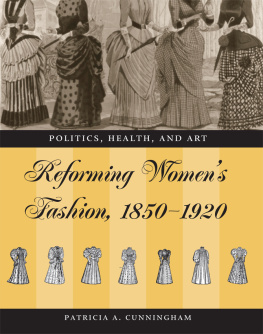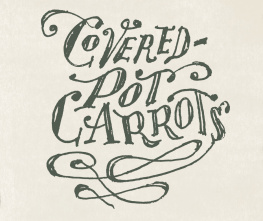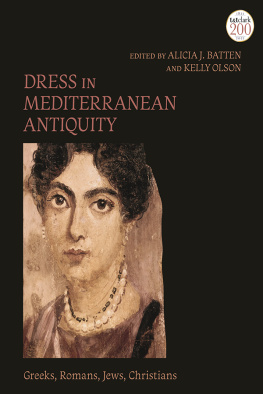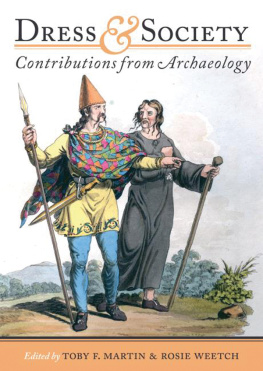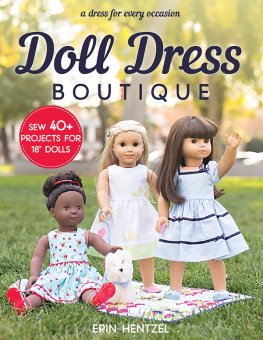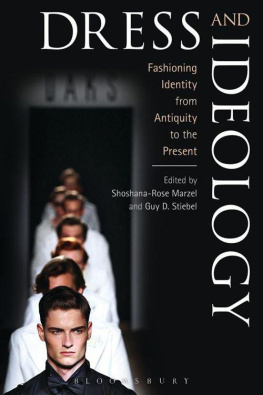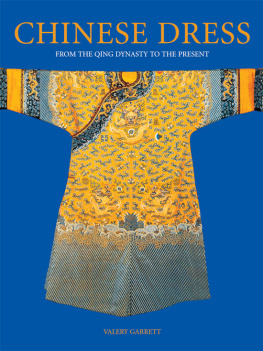Early Christian Dress
Routledge Studies in Ancient History
1 Cicero and the Catilinarian Conspiracy
Charles Matson Odahl
2 Ancient Graffiti in Context
Edited by Jennifer Baird and Claire Taylor
3 Early Christian Dress
Gender, Virtue, and Authority
Kristi Upson-Saia
Early Christian Dress
Gender, Virtue, and Authority
Kristi Upson-Saia
First published 2011
by Routledge
711 Third Avenue, New York, NY 10017
Simultaneously published in the UK
by Routledge
2 Park Square, Milton Park, Abingdon, Oxon OX14 4RN
Routledge is an imprint of the Taylor & Francis Group, an informa business
2011 Taylor & Francis
The right of Kristi Upson-Saia to be identified as author of this work has been asserted by her in accordance with sections 77 and 78 of the Copyright, Designs and Patents Act 1988.
Typeset in Sabon by IBT Global.
Printed and bound in the United States of America on acid-free paper by IBT Global.
All rights reserved. No part of this book may be reprinted or reproduced or utilised in any form or by any electronic, mechanical, or other means, now known or hereafter invented, including photocopying and recording, or in any information storage or retrieval system, without permission in writing from the publishers.
Trademark Notice: Product or corporate names may be trademarks or registered trademarks, and are used only for identification and explanation without intent to infringe.
Library of Congress Cataloging-in-Publication Data
Upson-Saia, Kristi, 1974
Early Christian dress : gender, virtue, and authority / by Kristi Upson-Saia.
p. cm. (Routledge studies in ancient history ; 3)
Includes bibliographical references and index.
1. Sex roleReligious aspectsChristianity. 2. Clothing and dressReligious aspectsChristianity. 3. Women in Christianity HistoryEarly church, ca. 30600. I. Title. II. Title: Gender, virtue, and authority.
BT708.U67 2011
391.00882701dc22
2011005280
ISBN13: 978-0-415-89001-4 (hbk)
ISBN13: 978-0-203-80645-6 (ebk)
To Steve
Est enim amicitia nihil aliud nisi omnium divinarum humanarumque rerum cum benevolentia et caritate consensio, qua quidem haud scio an excepta sapientia nil quicquam melius homini sit a dis immortalibus datum.
Cicero, De amicitia 6.20
Contents
Figures
Abbreviations
Throughout this book, I use existing translations of ancient sources or I offer my own translations. I cite the editions and translations I use in notes. Where no reference is listed, the translation is my own.
Abbreviations of ancient authors and their works are taken from G.W.H. Lampe (ed.), A Patristic Greek Lexicon (Oxford: Clarendon Press, 1961); Albert Blaise and Henri Chirat (eds.), Dictionnaire Latin-Franais des auteurs chrtiens (Turnout: Brepols, 1954); and Simon Hornblower and Antony Spawforth (eds.), Oxford Classical Dictionary , 3rd ed. (Oxford: Oxford University Press, 1996). Abbreviations of journal titles are taken from LAnne Philologique and Patrick H. Alexander, John F. Kutsko, James D. Ernest, Shirley A. Decker-Lucke, and David L. Petersen (eds.), The SBL Handbook of Style for Ancient Near Eastern, Biblical, and Early Christian Studies (Peabody, MA.: Hendrickson, 1999). Supplemental abbreviations are as follows:
| Act. Eugen. | Acta S. Eugeniae |
| AJS | American Journal of Sociology |
| AugSt | Augustinian Studies |
| BSNAF | Bulletin de la Socit Nationale des Antiquaires de France |
| B&CT | Bible & Critical Theory |
| BTB | Biblical Theology Bulletin |
| FemStud | Feminist Studies |
| G&H | Gender & History |
| IQ | International Quarterly |
| JHC | Journal of the History of Collections |
| JMEMS | Journal of Medieval and Early Modern Studies |
| RecAug | Recherches Augustiniennes |
| ROC | Revue de lorient chrtien |
| SP | Studia Patristica |
| Vit. Apoll. | Vita S. Apollinariae Syncleticae |
| Vit. Dan. | Vita Abba Daniel |
| Vit. Euphr. | Vita S. Euphrosynae, virginis |
| Vit. Hil. | Vita S. Hilariae |
| Vit. Mar. | Vita S. Marinae dicta Marinus |
| Vit. Matron. | Vita S. Matronae |
| Vit. Pelag. | Vita S. Pelagiae |
| Vit. Sus. | Vita S. Susannae |
Acknowledgments
This project began as a dissertation written at Duke University under the direction of Elizabeth A. Clark and Lucas Van Rompay. I am indebted to Liz and Luk for their guidance, their exacting feedback, and, most of all, their kindness and encouragement throughout. I feel incredibly fortunate to have been trained under their tutelage and to be a part of the Duke family. Liz has continued to offer feedback as the project progressed beyond a dissertation. Her generosity of time and spirit is matched only by her keen comments and suggestions.
I wish to thank the many other readers who have provided helpful suggestions at various stages of writing and revision and who offered much needed friendship and support: Bart D. Ehrman, Zlatko Plee, Julie Byrne, David Hunter, Susanna Drake, Kate Blanchard, Christine Luckritz Marquis, Kyle Smith, Tina Shepardson, Jeremy Schott, Andrew Jacobs, Catherine Chin, Pam Mullins Reaves, Eric Scherbenske, Stephanie Cobb, Jennifer Graber, Lori Baron, Bart Scott, Wendy Kim, and Steven Upson-Saia. I am exceedingly grateful for the thoughtful and detailed comments I received from the anonymous reviewers, who gave me excellent advice on how to layer my analysis and who saved me from several errors.
Over the last four years, my colleagues at Occidental College have provided me with an intellectually vibrant environment in which to complete this project. I would like to thank in particular my colleagues in the Department of Religious Studies, especially Dale Wright and D. Keith Naylor, the lively community of junior faculty, and participants of the Faculty Research Working Group. I am grateful for Occidentals generous pre-tenure leave, which enabled me the time to polish the manuscript, and for funding provided by a Faculty Enrichment grant from the deans office.
I would like to thank the editorial staff at Routledge, especially Laura Stearns and Stacy Noto, and Michael Watters at Integrated Book Technology, for ushering me through the review and publication process with ease. A shortened version of was originally published as Gender and Narrative Performance in Early Christian Cross-Dressing Saints Lives in Studia Patristica 45 (2010): 4348, and appears here by permission of Peeters Press (Leuven).
I owe the most to my friends and family without whose support this book, let alone a career in academia, would not be possible. First and foremost, I wish to thank my parents, Bob and Barb Upson, who never questioned the horizons open to me and who provided me with unparalleled encouragement. I owe many thanks to Gus and Mary Blanchard, who hospitably allowed me to finish revisions at their quiet and inspiring home at Torch Lake, and to Kate Blanchard, Chris Moody, and Gus Moody for a year we will never forget. Finally, I wish to thank my dear friends, especially Steve, for filling this journey with laughter and love.





